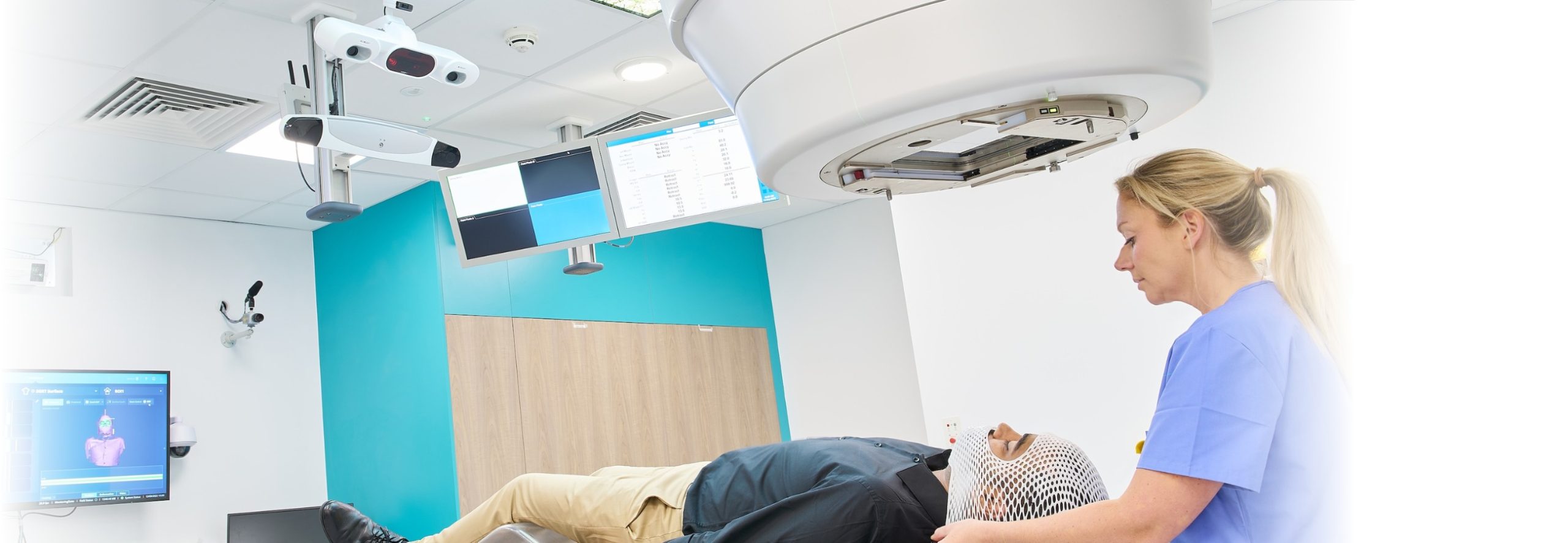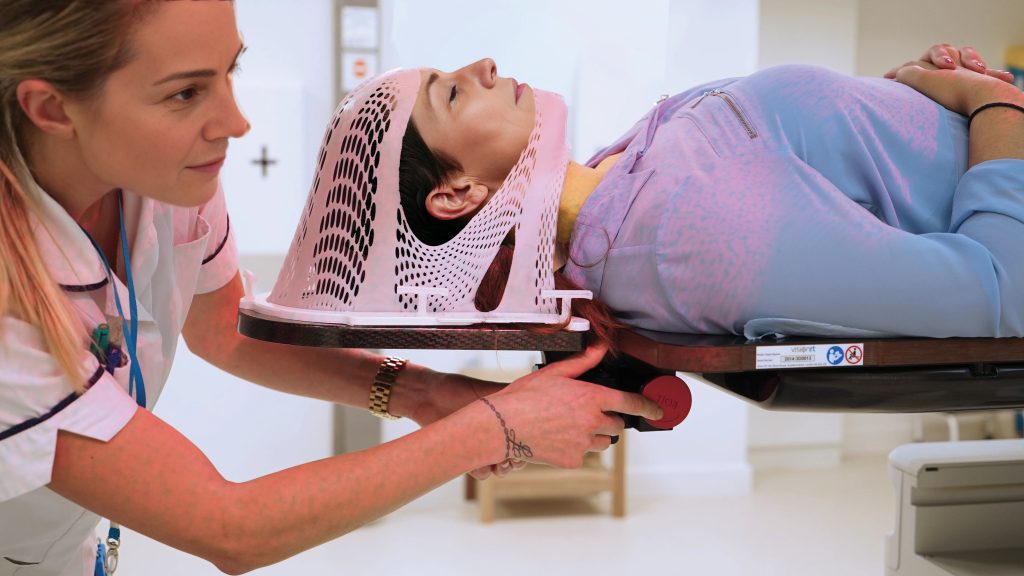Advancing Head and Neck Radiotherapy Treatments with SGRT
For Head & Neck radiation therapy, ensuring a patient’s position is accurately reproduced is critical for effective treatment and for minimizing side effects. Traditionally, full-face masks were used to achieve this, but those can cause patient discomfort and anxiety.
SGRT using AlignRT offers 0.5mm setup and treatment accuracy, helping clinics to transition to open-face masks – or even completely maskless treatments1 – while maintaining precise positioning.
AlignRT can help simplify treatment setups, reduce the need for rigid immobilization2, and track patient movement. Fully integrated into the treatment workflow, AlignRT automatically pauses the beam if movement is detected to help ensure safe and effective treatments while prioritizing patient comfort.
Research on Head and Neck Treatments with SGRT:
Studies have shown that patients have reported mask immobilizations, using closed-face masks, to be among the ‚worst‘ parts of their Radiation Therapy experiences3. Nearly half (43%) of patients reported clinically significant anxiety before their mask-making session4. Improving patient comfort while minimizing session disruption are key elements in improving treatment outcomes.
The results of a randomised trial concluded that a fully open 3-point mask used in conjunction with AlignRT improved patient experience, provided equivalent setup accuracy (to closed masks), and reduced replanning rates, supporting a new standard of care5.
The accuracy of AlignRT enables it to reduce the need for patient immobilizations, resulting in a superior patient experience, while still maintaining and improving the accuracy of setups2.
AlignRT, combined with the powerful combination of the Postural Video module, shows the outline of body parts to help ensure head, shoulders, and neck are all positioned correctly and has been shown in a study to ensure efficiency to reduce time per fraction by 90 seconds6.
Non-coplanar plans have been shown in multiple studies to deliver increased target dose or reduced organ-at-risk dose (including 19% mean and maximum dose reduction in one study for nasopharyngeal cancer7). One study shows both increased target coverage and simultaneously reduced dose to some organs at risk.
Read more about the advantages of non-coplanar treatment, which can be facilitated by the use of MapRT.
Head & Neck Workflow with SGRT:
Plan
MapRT provides the freedom to explore a greater variety of non-coplanar beams, optimizing target conformality while decreasing the dose to organs at risk (OAR). It enhances patient positioning on the treatment bed by allowing for a quick check to ensure there are no collisions when offsetting the patient. Removing the necessity for dry runs, it further reduces the number of patient visits, improving overall treatment efficiency.
Treat
AlignRT is designed to ensure high positional accuracy at all couch angles, fully compliant with ESTRO and AAPM guidelines. With a patient-centric approach, it minimizes immobilization and enables the use of open-face masks to enhance comfort. Additionally, the high-resolution, fast-frame-rate Postural Video further decreases setup time by 29% compared to standard SGRT8.
Dose
Hear from users on their clinical experiences:
“We can monitor this patient in real-time during the entire IGRT process using the SGRT system…by correcting the posture before IGRT, but also checking and monitoring to make sure he maintains that posture during IGRT evaluation.”
Michael Tallhamer Chief of Medical Physics AdventHealth Parker, USA.
“Minimal mask immobilisation allows for improved accuracy, improved reproducibility and certainly improved patient comfort…Making SGRT in the head and neck setting a primary safety tool for every fraction of every treatment.”
Daniel Bailey, Director of Physics and Dosimetry, Sarah Cannon.
- SGRT Community Annual US Meeting US (2020): Head and Neck Webinar: Data Driven Immobilization: SGRT in Head and Neck (2022), Michael Tallhamer, DABR, AdventHealth Parker, USA.
- Wei, W., Ioannides, P.J., Sehgal, V. and Daroui, P. (2020). Quantifying the impact of optical surface guidance in the treatment of cancers of the head and neck. Journal of Applied Clinical Medical Physics, 21(6), pp.73–82.
- Olausson, K., Holst Hansson, A., Zackrisson, B., Edvardsson, D., Östlund, U. and Nyholm, T. (2017). Development and psychometric testing of an instrument to measure the patient’s experience of external radiotherapy: The Radiotherapy Experience Questionnaire (RTEQ). Technical Innovations & Patient Support in Radiation Oncology, 3-4, pp.7–12.
- Burns, M., Campbell, R., French, S., Dhillon, H.M., Butow, P.N., Pritchard, A. and Sundaresan, P. (2022). Trajectory of anxiety related to radiation therapy mask immobilization and treatment delivery in head and neck cancer and radiation therapists’ ability to detect this anxiety. ‘Anxiety during radiation therapy with mask’. Advances in Radiation Oncology, p.100967.
- Malone C, Ryan S, Nicholson J, ‚Maolalai RO, O’Donovan R, McArdle O, Duane F, Armstrong J, Keenan L, Glynn A, Woods R, McClean B, Brennan S. Intrafraction motion stability of open vs. closed facemasks in head and neck radiotherapy: Insights from the OPEN phase III trial. Radiother Oncol. 2025 May 21;209:110941.
- “Large Network Approach: Streamlining Workflows and Increasing Efficiency” SGRT Community Meeting 2022 Presentation by Kira-Lee Oliver, Genesis Care Florida, June 2022.
- Subramanian VS, Subramani V, Chilukuri S, Kathirvel M, Arun G, Swamy ST, Subramanian K, Fogliata A, Cozzi L. Multi-isocentric 4π volumetric-modulated arc therapy approach for head and neck cancer. J Appl Clin Med Phys. 2017 Sep;18(5):293-300.
- Oliver K, Subick N, Moser T. A prospective, comparative evaluation of an augmented reality tool (Postural Video™) vs. standard SGRT for efficient patient setup. Rep Pract Oncol Radiother. 2025 Feb 19;29(6):740-745.

